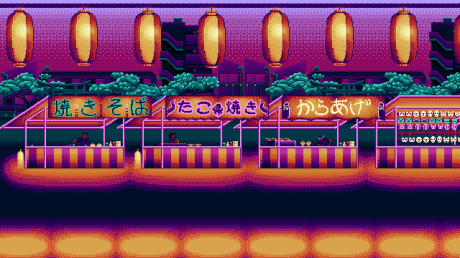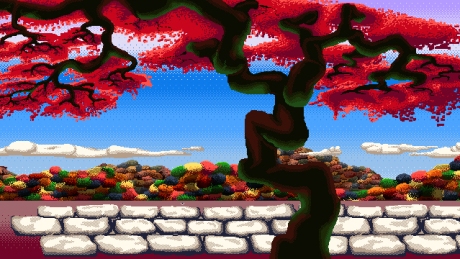Hoi! This is Leina, aka Reina (@rein_bel), because in the wonderful world of Hiragana we have a kana (れ) that does both. I am one of the two composers for Kana Quest.
Though I don’t come from a strictly musical background like Julian, I am a native Japanese speaker who grew up in Japan, listening to the kind of traditional and modern music that inspires Kana Quest’s soundtrack.

What makes a song ‘Japanese’? (And how do we stop being stereotypical?)
Let’s talk about Enka.
Enka is a type of Japanese ballad music. Modern enka developed in postwar Japan, and enjoyed a revival in the 70s that still continues to this day. Enka is characterised by its sentimental lyrics, use of traditional musical scales, and slow rhythm – often a single syllable can stretch for several notes!
https://www.youtube.com/watch?v=wwKIvbOqqcc
(This is the singer Sachiko Kobayashi performing Enka. Remember her now.)
Most people’s image of Japanese music may default to traditional Japanese folk music. Koto glissandos, taiko drums, that sort of thing. Have you heard of ‘Sakura Sakura’? It’s a well-known folk song that’s been popular since the Meiji period, and most kids are taught it at some point in their lives.

The song is in In scale, a musical scale used in Koto and Shamisen music. Coupled with the song literally being about cherry blossoms, it’s about as Japanese-y as you can get.
Then there’s also everyone’s favourite J-pop and J-rock, which evolved from the global 1960s pop and rock music phenomenon. The Beatles were explosively popular in Japan as they were everywhere else, and J-rock evolved from these influences well into the 70s, 80s, 90s and today. Nowadays Jpop is well-known for its peppy, upbeat energy and their prevalence in anime productions and pop culture.
So what does this have to do with Enka?
During the earlier stages of this project, Theo and I joked that most pop-culture depictions of Japan fell into two camps: ‘Samurai Drama’ and ‘Anime Girls’. Both of us had spent long periods of time living in Japan, and wanted to showcase the other facets of the culture that folks might not be as familiar with. Enka, with its roots in traditional Japanese music and western ballad music, is a perfect example of how modern music evolved into something distinctly recognisable to locals… but might not be as widely known elsewhere.

Japanese Instruments
Two instruments I used frequently in Kana Quest’s soundtrack are the Shamisen and Shakuhachi.
The Shamisen is a three-stringed instrument that originated in China via Okinawa. In particular, the Tsugaru Shamisen style is known for its percussive quality. Depending on how the strings are plucked with the Bachi (plectrum), different tones can be produced. A hard downwards pluck creates a distinctive snap or twanging sound, which often becomes the rhythmic backbone of Shamisen solos. A gentle up stroke produces a clean, almost Koto-like tone.
https://drive.google.com/file/d/1EnwMv7fNOoZlkcEd_wOzQ5E4Dr6Pu0uz/view?usp=sharing
The Shakuhachi is a bamboo flute known for its variable tone and breathy sound quality. In Japan, it’s known as an instrument played by Zen Buddhists as part of their meditation.
https://drive.google.com/open?id=133Cyrif5SxGdHEptwCJM4hcNCY4DIWf0
Production Process
As mentioned by Julian in the previous dev blog update, both of us have a hand in every track. For some of the earlier levels, Julian writes the backing track and sends it over to me. I then write the melody, and send it back for the final mix. On other tracks, the reverse is true– I write the majority of the track, but leave the keyboard and mixing to Julian’s mastery.
With so much back and forth between our two vastly different workflows and composing styles, it seemed like a bit of a risk jumping into the project– but it’s been anything but, and the final tracks are a beautiful fusion of traditional and modern that we’ve been looking for.

Conclusion
Now we’re seeing popularity in Japanese folk rock songs that reintroduce traditional Japanese instruments to modern music. Wagakki Band incorporate Shamisen, Shakuhachi and Wadaiko to their songs, and they came into the spotlight in the 2010’s through the power of the internet. Various independent Vocaloid producers have also begun using traditional Japanese instruments in their songs.
…Which brings us back to Sachiko Kobayashi, the Enka singer.
Here’s her performing a cover of the popular Vocaloid song ‘Senbonzakura’, in a virtual live performance in the popular MMO Phantasy Star Online 2.
https://www.youtube.com/watch?v=zyf7LvXOT4Y
Because “Folk-ballad singer wearing a mech suit in a virtual sci-fi MMO covers a folk J-rock song originally sung by a fictional anime android as cherry blossom petals swirl on stage” is something you really, really can only get in Japan.
Hi all, Theo here. Please give a big hand to Julian and Leina for writing the last two devblogs! I’ll be writing the the next devblog as usual, but I hope you all enjoyed reading Julian and Leina’s work as a change of pace.
However on the topic of the next Devblog, it will come out a week later that usual as the weekend the next devblog would come out the weekend of PAX Aus. Which, Kana Quest will be showing at this year!! So expect the next devblog on the 19th of October, not the 12th. But until then, have a great month. And if you want to read the devblog as soon as it comes out feel free to sign up to our mailing list at kanaquestgame.com